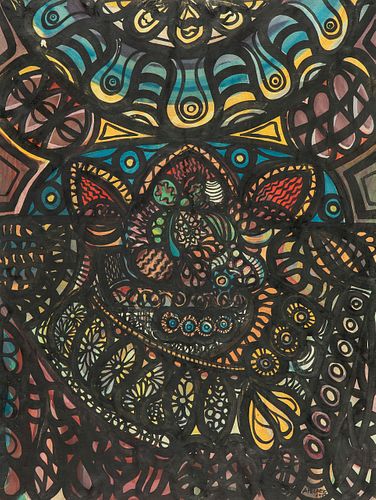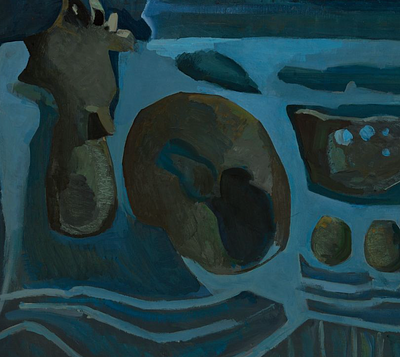AMELIA PELÁEZ (Cuba, 1896 - 1968). "Interior with still life", 1949. Mixed media on cardboard glued to canvas.
Lot 76
About Seller
Setdart Auction House
Carrer Aragó 346
Barcelona
Spain
Setdart Subastas was born in 2004 and is currently the first online art auction in Spain with solidity, prestige and reliability guaranteed by our more than 60,000 users. Setdart has a young, dynamic and enterprising team ready to successfully manage the purchase and sale of art works through custom...Read more
Categories
Estimate:
EUR€20,000 - EUR€25,000
$21,505.38 - $26,881.72
Absentee vs Live bid
Two ways to bid:
- Leave a max absentee bid and the platform will bid on your behalf up to your maximum bid during the live auction.
- Bid live during the auction and your bids will be submitted real-time to the auctioneer.
Bid Increments
| Price | Bid Increment |
|---|---|
| EUR€0 | EUR€10 |
| EUR€200 | EUR€25 |
| EUR€500 | EUR€50 |
| EUR€1,000 | EUR€100 |
| EUR€3,000 | EUR€200 |
| EUR€5,000 | EUR€500 |
| EUR€10,000 | EUR€1,000 |
| EUR€20,000 | EUR€2,000 |
| EUR€50,000 | EUR€5,000 |
About Auction
By Setdart Auction House
Jul 27, 2021
Set Reminder
2021-07-27 08:00:00
2021-07-27 08:00:00
America/New_York
Bidsquare
Bidsquare : CONTEMPORARY AND ACTUAL ART
https://www.bidsquare.com/auctions/setdart-auction-house/contemporary-and-actual-art-7261
Setdart Auction House sofia@setdart.com
Setdart Auction House sofia@setdart.com
- Lot Description
AMELIA PELÁEZ (Cuba, 1896 - 1968). "Interior with still life", 1949. Mixed media on cardboard glued to canvas. Signed and dated in the lower right corner. Certificate attached. Measurements: 61 x 46 cm; 87 x 72 cm (frame). Amelia Peláez is recognized as the first and only female artist to emerge from Cuba's avant-garde generation. The work we are dealing with, a variegated composition made in 1949, year in which she traveled for the third time to Europe, corresponds to the series of still lifes that Peláez began in 1936. It is a canvas bathed in her unmistakable aesthetic, with representations of fruits and flowers arranged on a background inspired by the colonial architecture that so moved the artist. Amelia Pelaéz painted her most interesting works during her maturity. At first, her aesthetics were closely linked to the academy. In 1916 she began her studies at the Academy of San Alejandro and in 1921 she went to New York. She commented at first that the United States did not bring her anything, but there she got in touch with modernity, coming into contact with different, new and avant-garde art. Finally she returned to the Academy of San Alejandro to finish graduating in 1926 with honors, and from the hand of Romanach, that is to say, from the hand of the most academic art. He then traveled to Paris in 1927 and stayed there for seven years. She arrived with a state commission, in order to investigate the schools and find out how the art scene was constituted. During this period Amalia immersed herself in art, which for her was a renewal. She enrolled at the Louvre school, also in that classical environment, and in 1931 she entered a newly opened academy, the contemporary academy of Fernand Léger, where there was a teacher who was an artistic revelation for Amelia. Alejandra Exter (1882-1949) Russian painter and designer, who followed the ideas of constructivism and exerted a great influence on the formation of Amalia. Through her works of geometric character and superimpositions of planes. Amelia found in the Europe of the avant-garde not the purism of these, but something more postmodern, but still interested her because it was a whole world of suggestions to assimilate and create a new aesthetic. In an article she wrote in a Paris newspaper about Cuban painters, she said that they were interested in the great masters of the contemporary in order to create a revolution in Havana. Those returning to Cuba assimilated the classical tradition, but were inspired by the themes of their country, although they were also interested in Gauguin, and the art of the blacks. In Paris he assimilated what he was seeing and made paintings of this type, with a strong weight based on figuration and post-avant-gardism. He opted for geometric rigor and broke with conventional space, betting on a purely plastic vision, typical of the avant-garde. In 1934 he returned to Havana, in the midst of political change, when Batista was coming to power. He secluded himself in his studio and dedicated himself to shaping his definitive work. He eliminated his academic burdens belatedly. When the catharsis of arriving in her homeland took place, she began to produce her own language, since it was in Havana where she realized that she did not want to be a simple painter of the School of Paris, but a modern and avant-garde Cuban artist. She got in touch with Wilfredo Lam, who knew in depth the Afro-Cuban traditions after coming from Paris and she herself ends up finding her style, looking at the city of Havana. She went through the city, her childhood memories, the craftsmanship, the roots, the stained glass windows, the latticework. In short, everything that defines the city of Havana as a chromatic city.
- Shipping Info
-
In-house shipping available. Please inquire at admin@setdart.com.
-
- Buyer's Premium



 EUR
EUR CAD
CAD AUD
AUD GBP
GBP MXN
MXN HKD
HKD CNY
CNY MYR
MYR SEK
SEK SGD
SGD CHF
CHF THB
THB














